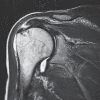Changes with time in skin temperature of the shoulders in healthy controls and a patient with shoulder-hand syndrome
- PMID: 20858148
- PMCID: PMC2971484
- DOI: 10.3109/03009734.2010.503354
Changes with time in skin temperature of the shoulders in healthy controls and a patient with shoulder-hand syndrome
Abstract
Background: Abnormal skin temperature in the shoulder is caused by various diseases. A thermography is unable to capture temperature changes over time. In contrast, a Thermocron is an effective measuring device to monitor temperature changes over time.
Purposes: The purposes of this study employing a Thermocron were to measure shoulder skin temperature over time in healthy subjects and to detect shoulder skin temperature abnormalities in a patient with shoulder-hand syndrome.
Subjects and methods: Subjects comprised 10 healthy volunteers (20 shoulders; 4 men and 6 women, mean age 54 years). For measurements, a Thermocron was attached on both shoulders. Measurements were made from 21.00 to 07.00 the following morning at 15-minute intervals.
Results: Gradual difference in right and left shoulder skin temperature was observed with the timing of measurements but no significant difference was apparent, i.e. dominant side 34.9 ± 0.8°C, non-dominant side 34.9 ± 0.9°C (P = 0.28). Presentation of a case with shoulder-hand syndrome. A 54-year-old woman with the diagnosis of rotator cuff tear underwent surgical treatment of rotator cuff repair, but the pain of the operated shoulder persisted due to phase 1 shoulder-hand syndrome. In postoperative week 3, skin temperature measurement using Thermocrons demonstrated a significant decrease in temperature on the operated side (affected side 34.3 ± 0.4°C, healthy side 35.2 ± 0.3°C; P < 0.05).
Conclusion: The changing of the skin temperature during night-time was successfully recorded both in the healthy subjects and a case with shoulder-hand syndrome using a Thermocron.
Figures






Similar articles
-
Shoulder surface temperature and bone scintigraphy findings in patients with rotator cuff tears.Ups J Med Sci. 2011 May;116(2):142-7. doi: 10.3109/03009734.2010.545150. Epub 2011 Feb 16. Ups J Med Sci. 2011. PMID: 21323485 Free PMC article.
-
Skin temperature of the shoulder: circadian rhythms in normal and pathologic shoulders.J Shoulder Elbow Surg. 1998 Nov-Dec;7(6):625-8. doi: 10.1016/s1058-2746(98)90012-x. J Shoulder Elbow Surg. 1998. PMID: 9883425
-
Reflex sympathetic dystrophy: skin blood flow, sympathetic vasoconstrictor reflexes and pain before and after surgical sympathectomy.Pain. 1996 Oct;67(2-3):317-26. doi: 10.1016/0304-3959(96)03136-3. Pain. 1996. PMID: 8951925
-
Revision arthroscopic rotator cuff repair: repair integrity and clinical outcome: surgical technique.J Bone Joint Surg Am. 2011 Mar;93 Suppl 1:62-74. doi: 10.2106/JBJS.J.01173. J Bone Joint Surg Am. 2011. PMID: 21411687
-
The latissimus dorsi tendon functions as an external rotator after arthroscopic-assisted transfer for massive irreparable posterosuperior rotator cuff tears.Knee Surg Sports Traumatol Arthrosc. 2020 Jul;28(7):2367-2376. doi: 10.1007/s00167-019-05819-2. Epub 2019 Dec 6. Knee Surg Sports Traumatol Arthrosc. 2020. PMID: 31811355
Cited by
-
Management of complications after rotator cuff surgery.Curr Rev Musculoskelet Med. 2015 Mar;8(1):40-52. doi: 10.1007/s12178-014-9247-6. Curr Rev Musculoskelet Med. 2015. PMID: 25532916 Free PMC article.
-
Shoulder surface temperature and bone scintigraphy findings in patients with rotator cuff tears.Ups J Med Sci. 2011 May;116(2):142-7. doi: 10.3109/03009734.2010.545150. Epub 2011 Feb 16. Ups J Med Sci. 2011. PMID: 21323485 Free PMC article.
References
-
- Jeracitano D, Cooper RG, Lyon LJ, Jayson MI. Abnormal temperature control suggesting sympathetic dysfunction in the shoulder skin of patients with frozen shoulder. Br J Rheumatol. 1992;3:539–42. - PubMed
-
- Vecchio PC, Adebajo AO, Chard MD, Thomas PP, Hazleman BL. Thermography of frozen shoulder and rotator cuff tendinitis. Clin Rheumatol. 1992;1:382–4. - PubMed
-
- Miyakoshi N, Itoi E, Sato K, Suzuki K, Matsuura H. Skin temperature of the shoulder: circadian rhythms in normal and pathologic shoulders. J Shoulder Elbow Surg. 1988;7:625–8. - PubMed
-
- Atkins RM. Complex regional pain syndrome. J Bone Joint Surg Br. 2003;85:1100–6. - PubMed
-
- Harden RN, Bruehl SP. Diagnosis of complex regional pain syndrome: signs, symptoms, and new empirically derived diagnostic criteria. Clin J Pain. 2006;22:415–9. - PubMed
Publication types
MeSH terms
LinkOut - more resources
Full Text Sources
